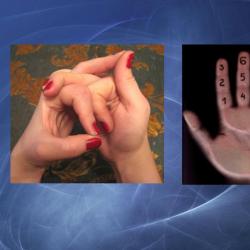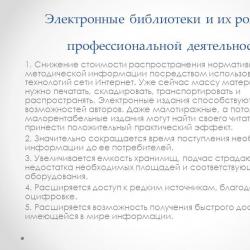Presentation on the topic "optics". Optics presentation for a lesson in physics (grade 11) on the topic of an incident beam and a perpendicular to
slide 1
Teaching aid for students Lecturer of the Blagoveshchensk Medical College Kachanova Irina Alekseevna 2011slide 2
 Optics Light sources Photometry Luminous flux Light beam. Light beam. The power of light. Illumination. Illumination standards
Optics Light sources Photometry Luminous flux Light beam. Light beam. The power of light. Illumination. Illumination standards
slide 3
 The branch of physics that studies light phenomena is called optics (from the Greek "opticos" visual), and light phenomena are usually called optical. Answer the questions: What ways of transferring influences exist? Give examples. What theories on the study of light were put forward and how did they differ? What is called geometric optics? Fundamentals of geometric optics. Work with the textbook Physics 11kl., G.Ya. Myakishev, B.B. Bukhantsev pp. 168 - 170.
The branch of physics that studies light phenomena is called optics (from the Greek "opticos" visual), and light phenomena are usually called optical. Answer the questions: What ways of transferring influences exist? Give examples. What theories on the study of light were put forward and how did they differ? What is called geometric optics? Fundamentals of geometric optics. Work with the textbook Physics 11kl., G.Ya. Myakishev, B.B. Bukhantsev pp. 168 - 170.
slide 4
 Ways of transmission of influences The transfer of a substance from a source to a receiver. (hit the string) Measurement of the state of the medium between bodies (without the transfer of matter). (place two strings side by side and sound waves from the first string, reaching the second, will cause it to sound)
Ways of transmission of influences The transfer of a substance from a source to a receiver. (hit the string) Measurement of the state of the medium between bodies (without the transfer of matter). (place two strings side by side and sound waves from the first string, reaching the second, will cause it to sound)
slide 5
 corpuscular This theory was studied by Newton Light is a stream of particles coming from a source in all directions (substance transfer) Difficulties: Why do light beams intersect in space wave filling all space penetrating inside all bodies Difficulties: Rectilinear propagation and formation of shadows Corpuscular and wave theories of light In the second half of the 19th century, light was considered as a wave. At the beginning of the 20th century, ideas about the nature of the set changed. Light, when emitted and absorbed, behaves like a stream of particles
corpuscular This theory was studied by Newton Light is a stream of particles coming from a source in all directions (substance transfer) Difficulties: Why do light beams intersect in space wave filling all space penetrating inside all bodies Difficulties: Rectilinear propagation and formation of shadows Corpuscular and wave theories of light In the second half of the 19th century, light was considered as a wave. At the beginning of the 20th century, ideas about the nature of the set changed. Light, when emitted and absorbed, behaves like a stream of particles
slide 6
 The phenomena of interference and diffraction could be explained if light was considered a wave The phenomena of radiation and absorption could be explained if light was considered a stream of particles Light interference addition of light waves Light diffraction around small obstacles. Light emission is the process of emitting and propagating energy in the form of waves and particles. Absorption of light Reduction of the intensity of light emission
The phenomena of interference and diffraction could be explained if light was considered a wave The phenomena of radiation and absorption could be explained if light was considered a stream of particles Light interference addition of light waves Light diffraction around small obstacles. Light emission is the process of emitting and propagating energy in the form of waves and particles. Absorption of light Reduction of the intensity of light emission
Slide 7
 Geometric optics A branch of optics that studies the laws of light propagation in transparent media, the laws of light reflection from mirror surfaces, and the principles of imaging when light passes through optical systems. Basic position of geometric optics Light propagates in a straight line
Geometric optics A branch of optics that studies the laws of light propagation in transparent media, the laws of light reflection from mirror surfaces, and the principles of imaging when light passes through optical systems. Basic position of geometric optics Light propagates in a straight line
Slide 8

Slide 9
 PHOTOMETRY (Greek photós - light and metréo - I measure) Photometry is a branch of OPTICS that studies how to measure light energy. Photometry as a science is based on the developed theory of the light field Light field is a region of space filled with light.
PHOTOMETRY (Greek photós - light and metréo - I measure) Photometry is a branch of OPTICS that studies how to measure light energy. Photometry as a science is based on the developed theory of the light field Light field is a region of space filled with light.
slide 10
 The value measured by the amount of energy that a light source emits per unit of time is called luminous flux Luminous flux time [s, min., hours] amount of energy [J] luminous flux [lm] (lumen)
The value measured by the amount of energy that a light source emits per unit of time is called luminous flux Luminous flux time [s, min., hours] amount of energy [J] luminous flux [lm] (lumen)
slide 11
 Part of the light flux, limited by a conical or cyclic surface, is called a light beam Light beam. Light beam. A light beam is the line in which a light beam travels A beam of light is the flow of light energy A beam of light is the direction in which energy travels
Part of the light flux, limited by a conical or cyclic surface, is called a light beam Light beam. Light beam. A light beam is the line in which a light beam travels A beam of light is the flow of light energy A beam of light is the direction in which energy travels
slide 12
 the part of space bounded by some conical surface is called a solid angle. Solid angle A solid angle is measured by part of a spherical surface ABCDEF Sphere area [m2] Sphere radius [m] solid angle [sr] (steradian)
the part of space bounded by some conical surface is called a solid angle. Solid angle A solid angle is measured by part of a spherical surface ABCDEF Sphere area [m2] Sphere radius [m] solid angle [sr] (steradian)
slide 13
 The value measured by the amount of energy that is emitted by a light source per unit of time inside a solid angle is called the luminous intensity The luminous intensity. Illumination luminous flux [lm] (lumen) solid angle [sr] (steradian) luminous intensity [cd] (candela) ) surface area [m2] illuminance [lx] (lux)
The value measured by the amount of energy that is emitted by a light source per unit of time inside a solid angle is called the luminous intensity The luminous intensity. Illumination luminous flux [lm] (lumen) solid angle [sr] (steradian) luminous intensity [cd] (candela) ) surface area [m2] illuminance [lx] (lux)
slide 14
 To preserve vision and create normal working conditions, it is necessary to maintain the most favorable illumination. Optimum illumination rates (lx) At the workplace for fine work .................. 200 For reading .................. 100 At the workplace for rough work. ......30 In corridors and on stairs.............15 Passages in rooms...............10 In streets and squares.... ......... 4 In yards and entrances............. 2 Very specific requirements are imposed on the illumination of the surgical field in surgery. The light falling on the surgical field should create a uniform optimal illumination with a minimum thermal effect, not tire the doctor and not create shadows. For this purpose, lamps of a special design, the so-called shadowless lamps, are used. Illumination standards
To preserve vision and create normal working conditions, it is necessary to maintain the most favorable illumination. Optimum illumination rates (lx) At the workplace for fine work .................. 200 For reading .................. 100 At the workplace for rough work. ......30 In corridors and on stairs.............15 Passages in rooms...............10 In streets and squares.... ......... 4 In yards and entrances............. 2 Very specific requirements are imposed on the illumination of the surgical field in surgery. The light falling on the surgical field should create a uniform optimal illumination with a minimum thermal effect, not tire the doctor and not create shadows. For this purpose, lamps of a special design, the so-called shadowless lamps, are used. Illumination standards
slide 15
 en.wikipedia.org › Wikipedia 5terka.com › Geometric optics images.yandex.ru › Yandex. Pictures http://www.bymath.net › All elementary mathematics
en.wikipedia.org › Wikipedia 5terka.com › Geometric optics images.yandex.ru › Yandex. Pictures http://www.bymath.net › All elementary mathematics
Optics
Slides: 11 Words: 5074 Sounds: 0 Effects: 0THE ORIGIN OF OPTICS. FLAT MIRROR (optics of early Antiquity). In 444 BC Greek philosopher Empedocles put forward a theory alternative to the idea of Pythagoras. The amazing foresight of Pythagoras was remembered at all stages of the creation of the corpuscular theory. Empedocles (c. 493 - 433 BC) - Greek philosopher from Agrigentum in Sicily. PELLUCID HYPOTHESIS. SYSTEMS OF FLAT MIRRORS (antique optics). He studied not only the laws of reflection, but also the refraction of light rays. Euclid was the author of the first Greek works on optics that have come down to us. Aristotle (384-322 BC) - ancient Greek philosopher and scientist. Born in Stagira. - Optics.ppt
Optics light
Slides: 16 Words: 688 Sounds: 0 Effects: 0Wave optics. quantum optics. Laws of geometric optics: The law of rectilinear propagation of light. The law of reflection of light. The law of refraction of light. The general criterion for the applicability of geometric optics is d » ?. Wave front - "border", a set of points of the same phase. Wave front. The formation of shade and penumbra from two sources. If the rays come from a point, a total shadow is created. The simplest optical phenomena. Reflection of light. Reflection angle? equal to the angle of incidence? The refractive index of a medium relative to vacuum is called the absolute refractive index. The laws of reflection and refraction are explained in wave physics. - Optics light.ppt
Optics and light
Slides: 14 Words: 102 Sounds: 0 Effects: 0Optics. Light. Properties of light: Wave: diffraction interference polarization. Quantum: photoelectric effect photosynthesis photography pressure of light chemical action of light. Properties of light that both waves and particles can have: Absorption reflection refraction dispersion. Light sources: Natural artificial. Geometric optics. Laws of geometrical optics: - Stable picture of addition of amplitudes of resulting fluctuations of coherent waves. Light interference. dispersion of light. polarization of light. proves that light is transverse EMW waves. Flat mirror. Camera. Eye, sight. - Optics and light.ppt
Fundamentals of Optics
Slides: 51 Words: 4371 Sounds: 0 Effects: 0Optics. Introduction. Experimental laws. Laws of reflection. Ray. Laws of refraction. The ratio of the sine of the angle of incidence. refractive indices. Flat mirror. Perpendicular to the mirror. spherical mirrors. A ray is incident on the mirror at point N. Reasoning and construction. Two of the three beams listed. The distance from the mirror to the object. We have obtained the mirror formula. Linear zoom. An object at a finite distance. Object between focus and mirror. Lenses. Collecting system. Straight lines passing through the optical center. Lenses are called divergent. Image of point S in the lens. Point images. - Fundamentals of optics.ppt
Optics grade 11
Slides: 8 Words: 141 Sounds: 0 Effects: 110Presentation project: "From sunbeam to geometric optics". Problem question. How is the law of reflection of light used in everyday life? The role of mirrors in human life, in everyday life and technology. Reflection of light. Mirror. Types of light reflections. Mirror reflection. diffuse reflection. What is nearsightedness and farsightedness. By means of the eye, and not by the eye, the mind knows how to look at the world. Myopia. The image of distant objects on the retina is fuzzy. Farsightedness. Glasses, types of glasses. - Optics grade 11.ppt
Section "Optics"
Slides: 23 Words: 573 Sounds: 0 Effects: 39Optical phenomena. Section of physics. Optics. Light. Electromagnetic radiation. Sources of light. Sections of optics. Geometric optics. Basic concepts. Laws of geometric optics. The law of rectilinear propagation of light. Solar and lunar eclipses. Reflections of the world. Types of reflections. Where does the mirror image form? The law of reflection of light. Light refraction. The law of refraction of light. Reflection and refraction of light. A ray of light. - Section "Optics".ppt
physical optics
Slides: 60 Words: 1977 Sounds: 0 Effects: 0Preparation for the exam in physics. The nature and properties of light. Optics. Light. Scale of electromagnetic waves. Radio waves. Infrared radiation. Ultraviolet radiation. X-ray radiation. Gamma radiation. dispersion of light. Refractive index of glass. Rainbow formation. Refraction. Beam of white light. The prisms must be the same. A beam of light. Light interference. Thomas Young's experiment. Two secondary light sources. Elementary ideas about interference. Interference maximum and minimum conditions. Interference of light in thin films. Newton's rings. What is wave interference. - Physical optics.pptx
Optics and atomic physics
Slides: 71 Words: 2094 Sounds: 0 Effects: 0Optics and atomic physics. Course of lectures on optics. Introduction. Optics is the study of light. At one time, optics played a decisive role in understanding the structure of the atom. Optical methods of control and measurement play a significant role. A bit of history. The first scientific theory of light. The need for an environment. Fundamentals of wave theory. Of Huygens' ideas, the general principle is the most valuable. Each point to which the light perturbation reaches. The speed of light in an optically denser medium. Interference experiments of Young and Fresnel. The wave theory of light was developed in the works of Euler and Lomonosov. - Optics and Atomic Physics.ppt
Wave and geometric optics
Slides: 96 Words: 4226 Sounds: 2 Effects: 56Vibrations and waves. Geometric and wave optics. optical radiation. Optical wavelength range. I. Newton's experiment. Geometric optics, without considering the question of the nature of light. Physical optics. laser device. The human mind transforms information. The results of physiological optics are used in medicine and physiology. The basic laws of geometric optics have been known since ancient times. Geometric optics is the limiting case of wave optics. Four laws of geometric optics, established empirically. The shadow cast by an object. -
1 slide

2 slide
Optics is the study of the nature of light, light phenomena and the interaction of light with matter. And almost all of its history is the history of the search for an answer: what is light?

3 slide
The history of the development of optics One of the first theories of light - the theory of visual rays - was put forward by the Greek philosopher Plato around 400 BC. e. This theory assumed that rays come from the eye, which, meeting with objects, illuminate them and create the appearance of the surrounding world. The views of Plato were supported by many scientists of antiquity and, in particular, Euclid (3rd century BC), based on the theory of visual rays, founded the doctrine of the rectilinear propagation of light, established the law of reflection.

4 slide
In the same years, the following facts were discovered: rectilinearity of light propagation; the phenomenon of light reflection and the law of reflection; the phenomenon of light refraction; focusing action of a concave mirror.

5 slide
The most interesting work on optics that has come down to us from the Middle Ages is the work of the Arab scientist Alhazen. He studied the reflection of light from mirrors, the phenomenon of refraction and the passage of light through lenses. Alhazen was the first to suggest that light has a finite propagation velocity. This hypothesis was a major step in understanding the nature of light.

6 slide
The main provisions of optics: Light is emitted, propagated and absorbed in discrete portions - quanta. A quantum of light - a photon carries an energy proportional to the frequency of the wave with which it is described by the electromagnetic theory E=h . A photon has mass (m=hv/c), momentum m=hv/c and angular momentum (_=h/2П).

7 slide
A photon, as a particle, exists only in motion, the speed of which is the speed of light propagation in a given medium. For all interactions in which a photon participates, the general laws of conservation of energy and momentum are valid. An electron in an atom can only be in some discrete stable stationary states. Being in stationary states, the atom does not radiate energy. During the transition from one stationary state to another, an atom emits (absorbs) a photon with a frequency v=E –E /h, (where E1 and E2 are the energies of the initial and final states).

8 slide
The eye as an optical system. The organ of human vision is the eyes, which in many respects represent a very perfect optical system.

9 slide
In general, the human eye is a spherical body with a diameter of about 2.5 cm, which is called the eyeball. The opaque and strong outer shell of the eye is called the sclera, and its transparent and more convex front part is called the cornea.

10 slide
C onclusion: The field of phenomena studied by physical optics is very extensive. Optical phenomena are closely related to phenomena studied in other branches of physics, and optical research methods are among the most subtle and accurate. Therefore, it is not surprising that for a long time optics played a leading role in very many fundamental research and the development of basic physical views. Suffice it to say that both main physical theories of the last century - the theory of relativity and the theory of quantum - originated and developed to a large extent on the basis of optical research. The invention of lasers opened up vast new possibilities not only in optics, but also in its applications in various branches of science and technology.
slide 1
Teaching aid for students
Teacher of the Blagoveshchensk Medical College Kachanova Irina Alekseevna

slide 2
Optics Light sources Photometry Luminous flux Light beam. Light beam. The power of light. Illumination. Illumination standards

slide 3
The branch of physics that studies light phenomena is called optics (from the Greek "opticos" visual), and light phenomena are usually called optical.
Answer the questions: What ways of transferring influences exist? Give examples. What theories on the study of light were put forward and how did they differ? What is called geometric optics? Fundamentals of geometric optics.
Work with the textbook Physics 11kl., G.Ya. Myakishev, B.B. Bukhantsev pp. 168 - 170.

slide 4
Ways to transfer influences
The transfer of matter from a source to a receiver. (hit the string) Measurement of the state of the medium between bodies (without the transfer of matter). (place two strings side by side and sound waves from the first string, reaching the second, will cause it to sound)

slide 5
corpuscular
Newton studied this theory. Light is a stream of particles coming from a source in all directions (substance transfer) Difficulties: Why do light beams intersect in space
wave
Huygens was engaged in the study of this theory Light - these are waves propagating in a special hypothetical medium - ether, which fills all space and penetrates into all bodies Difficulties: Rectilinear propagation and the formation of shadows
Corpuscular and wave theories of light
In the second half of the 19th century, light was considered as a wave.
At the beginning of the 20th century, ideas about the nature of the set changed. Light, when emitted and absorbed, behaves like a stream of particles

slide 6
The phenomena of interference and diffraction could be explained by considering light as a wave
The phenomena of emission and absorption could be explained if light was considered a stream of particles
Light interference addition of light waves
Diffraction of light around small obstacles.
Light emission is the process of emitting and propagating energy in the form of waves and particles.
Absorption of light Reduction of the intensity of light emission

Slide 7
geometric optics
A branch of optics that studies the laws of light propagation in transparent media, the laws of light reflection from mirror surfaces, and the principles of imaging when light passes through optical systems.
Basic position of geometric optics
Light travels in a straight line

Slide 8
Artificial Natural Stars Comet Sun Splinter Lamp Light Sources Candle Bacteria On Fish Bonfire True

Slide 9
PHOTOMETRY (Greek photós - light and metréo - I measure)
Photometry
section of OPTICS in which they study how to measure light energy.
Photometry as a science is based on the developed theory of the light field
A light field is an area of space filled with light.

Slide 10
The quantity measured by the amount of energy emitted by a light source per unit of time is called luminous flux.
Light flow
time [s, min, hours]
amount of energy [J]
luminous flux [lm] (lumen)

slide 11
Part of the light flux, limited by a conical or cyclic surface, is called a light beam
Light beam. Light beam.
light beam the line along which the light beam propagates
A light beam is a stream of light energy
A light beam is the direction in which energy travels.

slide 12
the part of space bounded by some conical surface is called a solid angle.
Solid angle
The solid angle is measured by part of the spherical surface ABCDEF
Sphere area [m2] Sphere radius [m]
solid angle [sr] (steradian)

slide 13
The value measured by the amount of energy that is emitted by a light source per unit time inside a solid angle is called the luminous intensity
The power of light. illumination
luminous intensity [cd] (candela)
The value measured by the amount of light energy supplied per unit surface of the body in one second is called illumination.
surface area [m2]
illumination [lx] (lux)

Slide 14
To preserve vision and create normal working conditions, it is necessary to maintain the most favorable illumination. Optimum illumination rates (lx) At the workplace for fine work .................. 200 For reading .................. 100 At the workplace for rough work. ......30 In corridors and on stairs.............15 Passages in rooms...............10 In streets and squares.... ......... 4 In yards and entrances............. 2 Very specific requirements are imposed on the illumination of the surgical field in surgery. The light falling on the surgical field should create a uniform optimal illumination with a minimum thermal effect, not tire the doctor and not create shadows. For this purpose, lamps of a special design, the so-called shadowless lamps, are used.
Illumination standards

slide 15
literature
en.wikipedia.org › Wikipedia 5terka.com › Geometric optics images.yandex.ru › Yandex. Pictures http://www.bymath.net › All elementary mathematics






